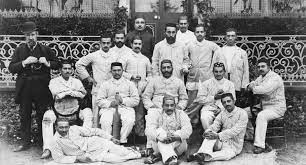First Parsi team to U.K , 1886
Presidency Matches
The seed of cricket was first planted
on Indian soil by the Britons. Among the Indians, the Parsees of Bombay were
the first to try their hand at the ‘white man’s sport’.
In India the Britons and the Parsees
were the first to have cricket clubs, Calcutta Cricket Club (1792) and Orient Cricket
Club (1848) respectively. They were the first to play cricket among themselves
and the first to promote the game on Indian soil.
The Parsees began to play against the
Europeans to further their social and commercial interests. In 1877 Parsee CC
beat a British side at a ‘friendly’ cricket match in Bombay. This incident
happens to be the first instance of the Europeans losing to the local
population on the sports field in any discipline on Indian soil. Unfortunately
this fact has been conveniently ignored by our sports historians.
The advent of the great Parsee
all-rounder Mehellasha Pavri (Tribute Posted Earlier) caused a flutter in the
European camp in the late 1880s. His destructive bowling proved to be far too
strong for the Bombay-based European expatriates. The Parsees were the first
among Indian communities to defeat the colonial rulers regularly on the sports
field.
In 1889-90 a team from England, led by former
Test cricketer George Frederick Vernon, arrived in India to play a number matches
around the country. The very influential persona of Lord Hawke (Martin Bladen)
came as a playing member. At Bombay the visiting Britons met their match as the
Parsees humbled them.
These factors combined to make the
Europeans in Bombay realize that to develop a meaningful resistance to the
Parsee team, they must involve European players based in other Indian cities.
The Governor of Bombay, Lord Harris (George Robert Canning) suggested that
Europeans from neighbouring regions in the Bombay Presidency should be
considered.
Lord Harris was a former Test
cricketer of England and a very powerful influence on the corridors of England
cricket. For a person of Lord Harris’ stature to acknowledge the undoubted
class of the Parsee cricketers was a big leap forward for Indian cricket.
Thus from 1892 the Europeans
announced that they would select a combined team with players from all over the
Bombay Presidency. To include European players from beyond Mumbai was certainly
a major step forward for Indian cricket at the time because it clearly indicated
that the Europeans in India had come to respect the Indians' ability at
cricket.
Two matches were played every year
from 1892 to 1906, one in Mumbai and the other in Poona. These matches came to
be known as Presidency Matches and are considered to be the earliest
first-class matches played on Indian soil.
For 15 years, the two teams played
each other 26 times with four matches being abandoned for either heavy rain or
outbreak of plague, which was quite common at the time. The Europeans won 10
and the Parsees 11, with the honours shared in 5 matches.
The first centurion for the Parsees
was DD Daruwalla, when he raced to 113 at Poona in 1903-04. However the credit
for the only double century in the Presidency matches goes to Dr HD Kanga when
in an innings of rare authority he smashed 233 at the Poona Gymkhana ground in
1905-06.
Here it must be recorded that most of
the matches were played during the monsoon months. The wet pitches favoured the
bowlers and consequently most of the matches ended in low scores. The reason
for these cricket matches to be organized in the rainy season is an issue of
perpetual conjecture.
Apart from the outstanding
all-rounders Mehallasha Pavri and KM Mistry, the Parsee heroes were Rustomji Meherhomjee,
a graceful batsman, the fast bowlers Baman Bilimoria, M.D. Bulsara, D.N. Writer
and A.H. Mehta and the magnificent all-rounder N.C. Bapasola. BC Machliwalla,
KS Kapadia and DD Kanga were consistent contributors as well.
For the Europeans the prominent performers
were John Glennie Grieg, a Jesuit priest, and an army man, Reginald Montagu Poore.
Hard-hitting Poore’s 100 not out at Bombay in August 1895 was the first century
of Presidency matches. Within months, by early 1896 the brigadier was representing
South Africa in Tests against England.
JG ‘Junglee’ Greig was the cynosure of all
eyes with his elegance and consistency both with bat and ball. His was a
calming, cultured influence which evoked respect from even his opponents. Reverend
Grieg was the first man to highlight the awesome talents of the Hindu ‘Harijan’
cricketer, Palvankar Baloo (Tribute Posted Earlier).
Here it may be of interest to note
that the famous England captain of the 1930s Douglas Jardine was born in Bombay
in 1900 when his cricket-playing father Malcolm Robert Jardine was the Advocate-General
of Bombay Presidency. The senior Jardine (born at Simla in 1870), former county
player, represented the Europeans in Presidency matches.
The early Parsee cricket historians,
Shorabjee Shapurjee Bengalee, Cawasji Jehangir and J.M. Framjee Patel, and
later writers, Mehellasha Pavri and P.N. Polishwala deserve special mention. Without
their classic treatises, the early chapters of Indian cricket would never have
come to light.
These visionaries were the earliest
patrons of Indian cricket. Every Indian cricket lover owes a deep
sense of gratitude to the Parsees of Bombay who first planted the seed of the
noble sport in the Indian mind.

No comments:
Post a Comment